Perhaps when you first set up your aquarium, you chose sand as your substrate, and are now wondering what type of plants would work best in it.
In this article, I’ll be showing you the top aquarium plants that are most suitable for a sandy substrate so that you can quickly set your tank up and make your fish feel at home.
Before we dive into the list of plants, let’s first take a look at why plants typically have a difficult time growing in the sand so that you can understand why the plants we’ve listed are better alternatives.
Do Plants Grow in Sandy Substrate?
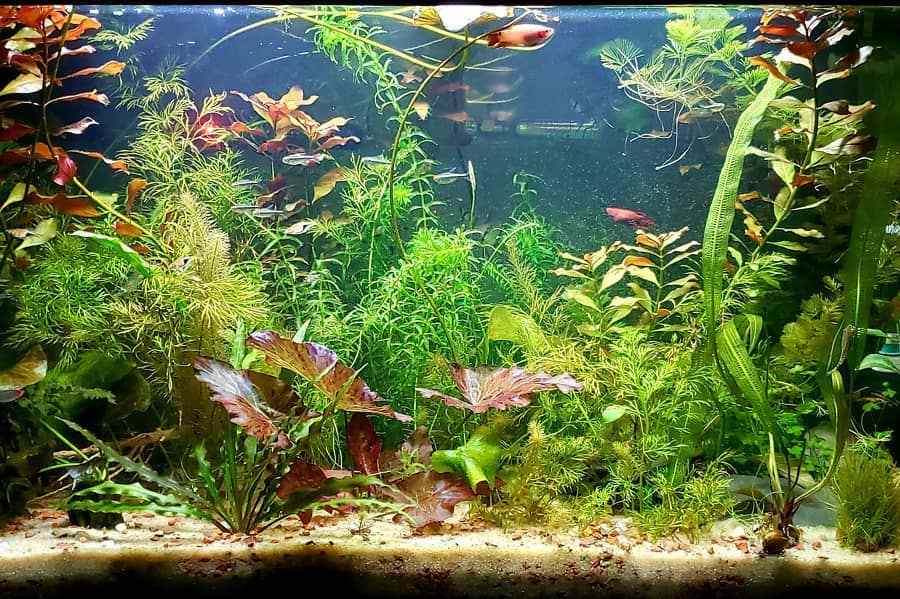
Some plants do grow in a sandy substrate; however, the majority are limited in their growth, and some may even die due to several factors:
The Sand Itself Presents a Problem
Because the sand substrate is denser than aqua soil, it makes it difficult for many plants to form strong root structures in it. Many types of plants have roots that are too delicate and, in turn, the sand will eventually cause the plants to float as they’ll have nothing to attach to.
The Sand is Not Nutrient Rich
Another issue with the sand substrate is that it isn’t nearly as packed with nutrients as aqua soil is. Because the majority of plants rely on this source of nutrition as their main way of survival, even the most resilient plants will suffer.
Why Do People Use a Sandy Substrate?
Despite the challenges of plants living in sand, many people still choose to use sandy substrate mainly due to its versatility, its closeness to nature, and its usefulness to various fish species.
Sand Substrate is Versatile
Because sand is lighter and softer than aqua soil, it’s a lot easier to manipulate for a range of needs. Therefore, by using sand, you’ll be able to open up your creative mind and achieve a variety of different layouts for your aquarium that matches your style.
Aquarium Sand is Found in Nature
Sand is one of the few substrates commonly found in nature, thus it’s often a great option to use if you’re looking to create an aquarium with a natural look, such as one similar to a fish’s natural habitat.
Sand Can Be Used in Various Ways
Many fish species use sand as part of their natural lifestyles.
The Corydoras, for example, spend much of their time sifting through sand looking for food. Therefore, it’s important for these fish not to spend time in an aquarium with grain gravel as that can damage their bodies as they sift through them.
Now that you understand the difficulties of living in sand, let’s move on to the list.
Types of Plants That Live in Sand
1. Amazon Sword
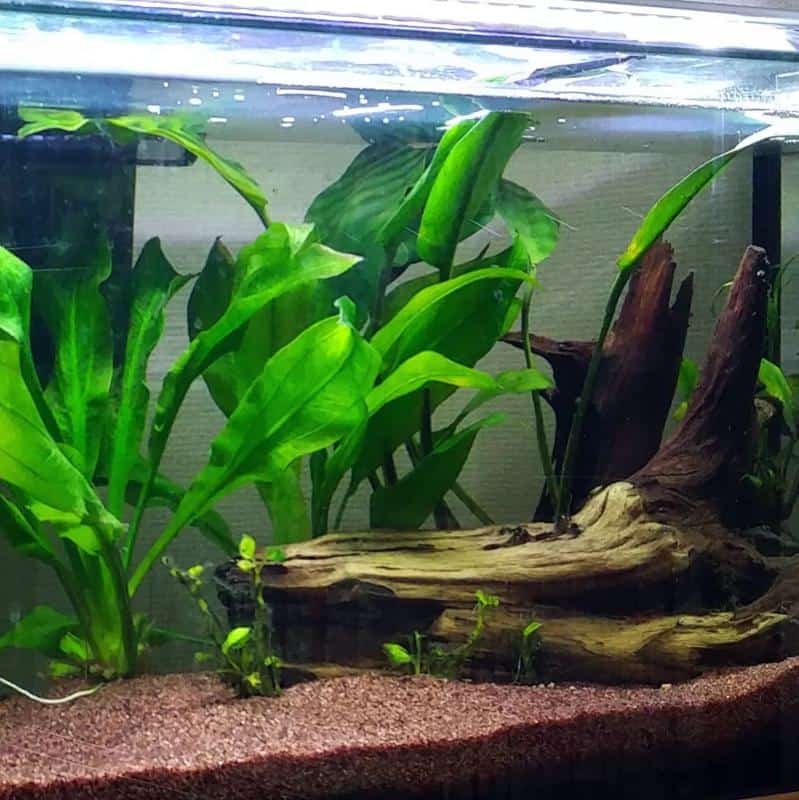
The amazon sword is a common starter plant that is known to grow well in sandy substrate. It can adapt to a wide range of growing conditions.
Appearance
The amazon sword is a large plant with similarly long leaves, somewhat resembling kelp. They can grow to about 20 inches in length.
How to Grow
To plant the amazon sword, you’ll need to bury its roots into the substrate, making sure not to bury its crown. Fertilizer will need to be provided regularly in the form of root tabs to keep it healthy as it’s quite a heavy root feeder.
You’ll need a large enough space to take care of it due to its large size (you may be able to find smaller varieties if you have limited space). You may prune the plant by cutting the outer leaves from the bottom.
This plant requires medium light, and combining it with ample CO2 will allow this plant to grow and spread quickly.
| Maintenance | Medium |
| Temperature | 72-85 F |
| pH | 6.5-7.5 |
| Size | 20” |
| Lighting | Moderate |
| Fertilizer Type (if Required) | Iron Rich and Root Tabs |
2. Java Fern

The java fern is known to be one of the most popular aquarium plants for sandy substrates due to its light maintenance requirements. Because it’s a slow grower and baby ferns can be carried by a current to a new location where it attaches itself, it may take some time for you to notice it in your tank.
Appearance
The java fern’s appearance can vary depending on its geographic region, however, they share common traits such as being roughly 10 inches tall when fully grown and consisting of creeping green rhizomes.
How to Grow
The java fern has difficulty burying its roots, therefore it’s best if you anchor it to a piece of driftwood or rock. However, if you can bury its roots up to (but not including) the rhizomes, there’s a chance it can grow in the sandy substrate (as long as the rhizomes are above the sand, the plant will continue to grow).
Other than the initial setup, the java fern is rather easy to grow and requires little light and CO2. However, it’ll still be recommended to provide some liquid fertilizer (since the plant doesn’t have an advanced root system, you should use liquid instead of root tabs) to accelerate its growth.
| Maintenance | Low |
| Temperature | 68-82 F |
| pH | 6-7.5 |
| Size | 13.5” |
| Lighting | Low to Moderate |
| Fertilizer Type (if Required) | Liquid fertilizer optional |
3. Java Moss

The Java Moss is another popular plant among aquarium hobbyists and is relatively easy to maintain since its highly adaptable to a variety of environments.
Appearance
The java moss consists of oval-shaped leaves which are smaller than those of most other plants. However, its leaves can look brighter and larger when the plant is grown underwater than when it’s grown on land.
How to Grow
The Java Moss is easy to grow since it can tolerate a wide range of conditions and substrates. Instead of roots, it has rhizoids that anchor it to any surface and allows the plant to absorb nutrients through its upper parts.
To make the Moss into a carpet, be sure to weigh it down, use little current, and have no fish disturb it. As long as you have sufficient light and nutrients, it’ll slowly spread into a carpet.
The Moss doesn’t require much fertilizer (if any) or CO2. However, you may trim it occasionally if you wish to keep it short.
| Maintenance | Low |
| Temperature | 68-82 F |
| pH | 6-7.5 |
| Size | 8” |
| Lighting | Low to Moderate |
| Fertilizer Type (if Required) | N/A |
4. Anubias Barteri
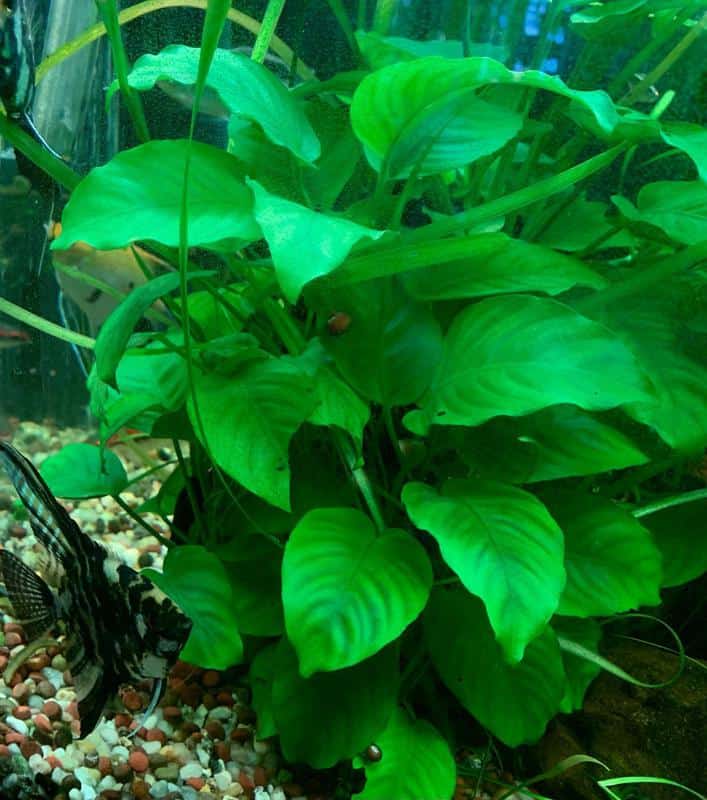
Anubias Barteri is another plant that grows well in sandy substrate since you don’t bury its roots in the substrate, similar to the java moss. It is a slow grower.
Appearance
The Anubias Berteri comes in various sizes and has leaves that are durable, wavy, and of a dark green color. Its stem is particularly long and can grow up to 40 cm.
How to Grow
Like the java moss, this plant is happiest when it’s attached to rocks or driftwood, however, it can survive anchored in the substrate; just be sure not to bury its rhizomes.
It’s best to avoid strong lighting or leaving the plant in the light too long as that can lead to algae blooms and harm the plant.
This plant doesn’t require much CO2 or fertilizer; however, you can choose to use the latter to help your plant grow faster.
| Maintenance | Low |
| Temperature | 72-82 F |
| pH | 6.5-7.5 |
| Size | 12” |
| Lighting | Low to Moderate |
| Fertilizer Type (if Required) | N/A |
5. Anacharis Elodea (Waterweeds)
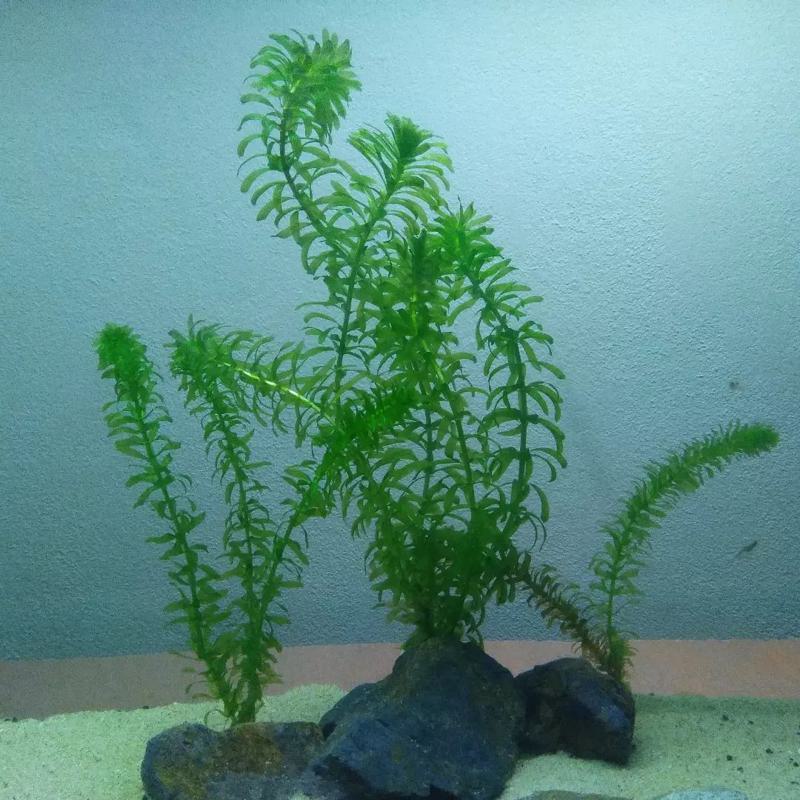
Another relatively easy-maintenance plant that grows well in the sand is the Anacharis Elodea. Though easy to prep, this plant grows very quickly once settled, so it’s necessary to keep an eye on it regularly.
Appearance
The Anacharis Elodea has thin leaves that form rings or whorls that can extend throughout its stems to its single root base. They may appear bright green to dark, seaweed-like green in color.
How to Grow
This plant is easy to set up as it can grow on nearly any substrate and doesn’t need CO2. Just root it in the substrate and it’ll quickly settle in.
Because this plant grows quickly, you’ll need to trim it regularly by cutting off any unwanted bits with a scissor. Make sure to dispose of the cuttings as they can grow into new plants.
Make sure to provide proper lighting, as too little can cause it to wither and die.
Be sure you use the right liquid fertilizer, and the plant will take care of itself.
| Maintenance | Medium |
| Temperature | 59-82 F |
| pH | 6.5-7.5 |
| Size | 24” |
| Lighting | Moderate |
| Fertilizer Type (if Required) | Liquid fertilizer |
6. Ludwigia Repens
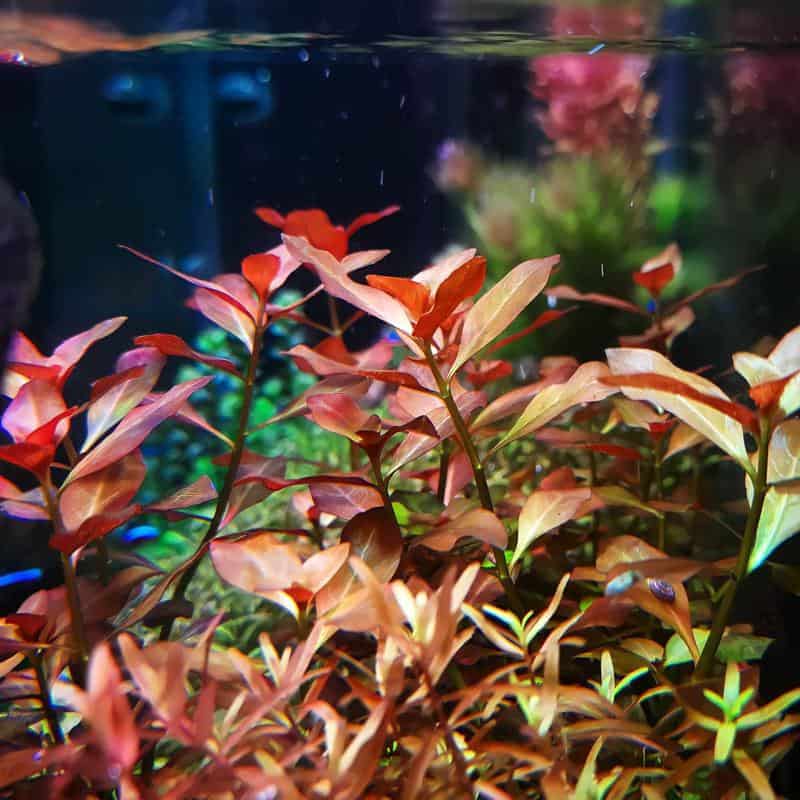
The Ludwigia Repens is a hardy plant that can grow both fully in the water or partially submerged.
Appearance
The Ludwigia Repens is a trailing plant that grows to long lengths and contains thick stems.
The stems are usually red or rusty colored, with some variants having green as well. These stems then form nodes which become runners later on.
How to Grow
Ludwigia Repens can be grown either fully or partially submerged, so you don’t need to worry about it growing above the water. If you’d like the plant to grow more full or bushy, consider trimming it as the new leaves will grow out of the stem below the piece you had previously cut off.
Ensure that the plant receives plenty of light, as low light can cause it to lose its color and leaves. Fertilizer is not mandatory for this plant but root tabs are recommended if you’d like a healthier-looking plant.
| Maintenance | Medium |
| Temperature | 72-82 F |
| pH | 6.5-7.5 |
| Size | 8” |
| Lighting | Moderate to high |
| Fertilizer Type (if Required) | Root tabs optional |
7. Madagascar Lace
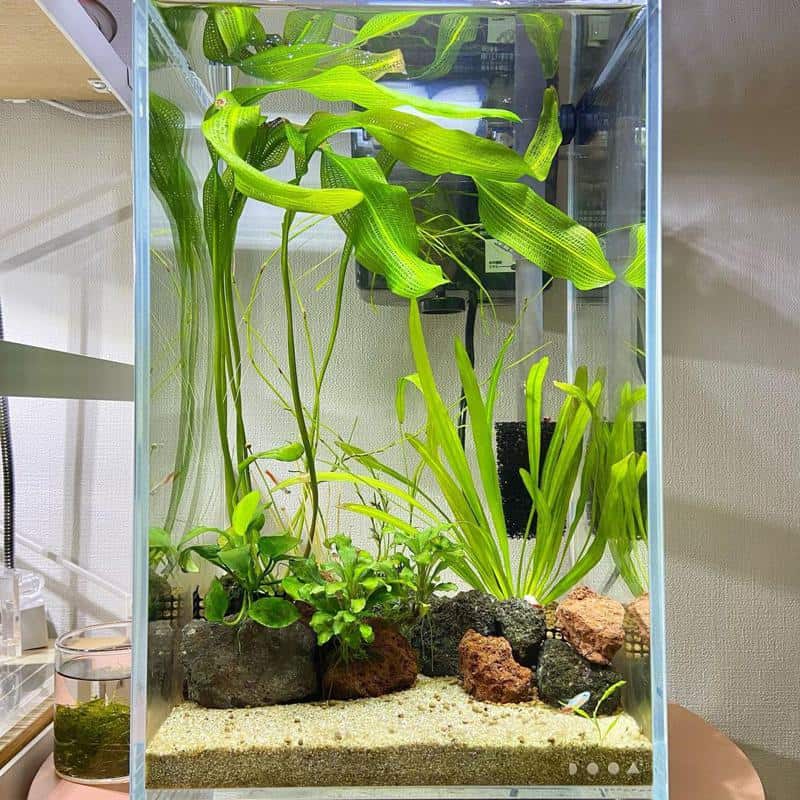
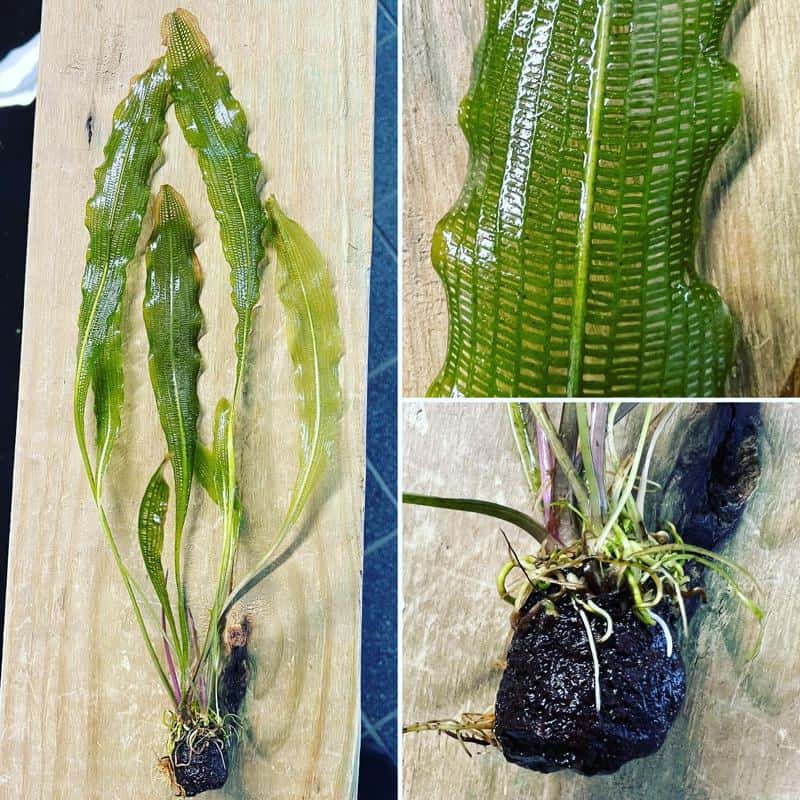
The Madagascar lace is a beautiful plant that can brighten your aquarium, however, it’s one of the toughest plants on this list to maintain.
Appearance
The Madagascar lace grows quite large (up to a height of 10 to 25 inches and a width of 10 to 12 inches) and consists of individual, green oblong leaves that resemble an intricate web or net.
How to Grow
Madagascar lace requires very careful maintenance when growing in sand, however, it is possible, especially with coarse sand such as black diamond blasting sand.
Growing this plant in the sand will require plenty of light and regular fertilization. You should use a water column fertilizer instead of root tabs since this plant seems to thrive in nutrient-poor soil.
Make sure to adjust your water to the following standard to ensure maximum plant growth:
| Maintenance | High |
| Temperature | 62-72 F |
| pH | 6-7 |
| Size | 25” |
| Lighting | High |
| Fertilizer Type (if Required) | Water Column with Iron and Trace Elements |
8. Cabomba
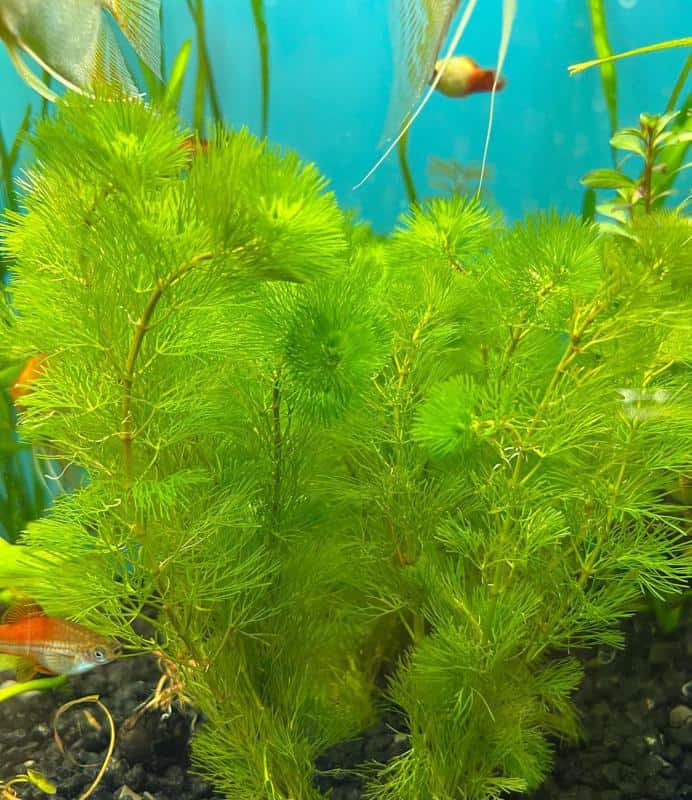
The Cabomba is a relatively easier plant to manage compared to the Madagascar lace, however, it is just as distinctive.
Appearance
The Cabomba has branched stems that grow up to 10 meters long and is covered with white or brownish-white hairs. The leaves are divided underwater to take on a fan-like appearance.
How to Grow
The Cabomba sucks nutrients from the water and thus is very adaptable to the sand, and will easily grow if you have sufficient light, CO2, and liquid fertilizer. Make sure you use the medium to high lighting and add pressurized CO2 to the water if you wish for it to grow well, especially when flowering.
| Maintenance | Medium |
| Temperature | 72-82 F |
| pH | 6.5-7.5 |
| Size | 20” |
| Lighting | Moderate |
| Fertilizer Type (if Required) | Liquid fertilizer |
Related: Best Aquarium Plants with Flowers
9. Vallisneria
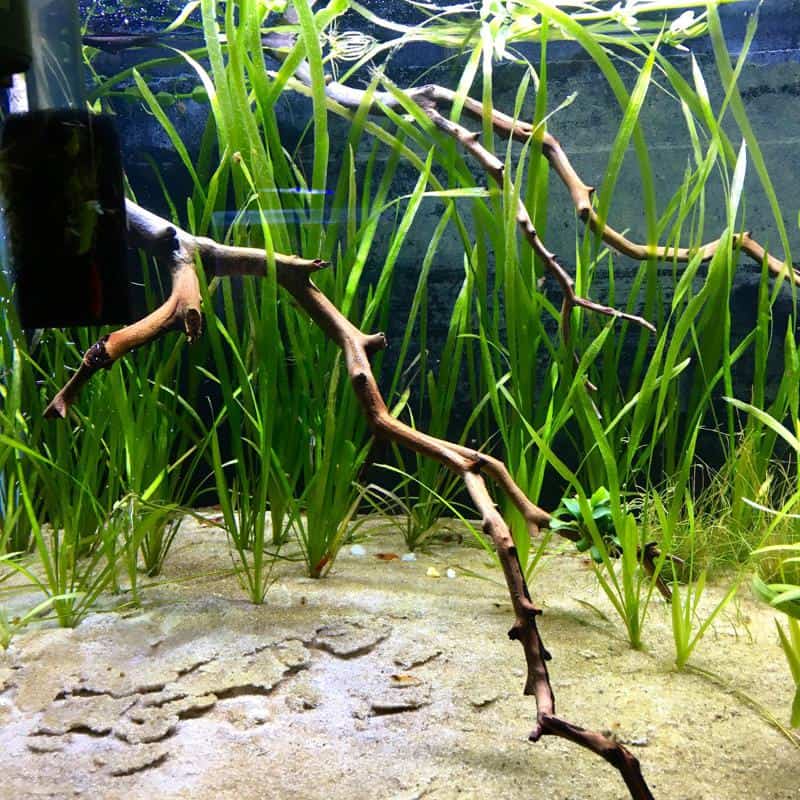
The Vallisneria is a rather easy maintenance plant that serves well in the background of your aquarium.
Appearance
The Vallisneria has bright green, ribbon-shaped leaves with 5 longitudinal veins. These leaves are typically half an inch wide and up to 20 inches long, but can grow longer in their natural habitat.
How to Care
This plant grows well in the sand and, when paired with medium to high lighting and root tabs, can easily spread out.
Its shoots will spread along the substrate and create daughter plants every few inches/centimeters. If they’re taking over the tank, you can snip them off with scissors.
| Maintenance | Low |
| Temperature | 68-82 F |
| pH | 6.5-8 |
| Size | 20” |
| Lighting | Moderate to High |
| Fertilizer Type (if Required) | Root Tabs |
10. Cryptocoryne
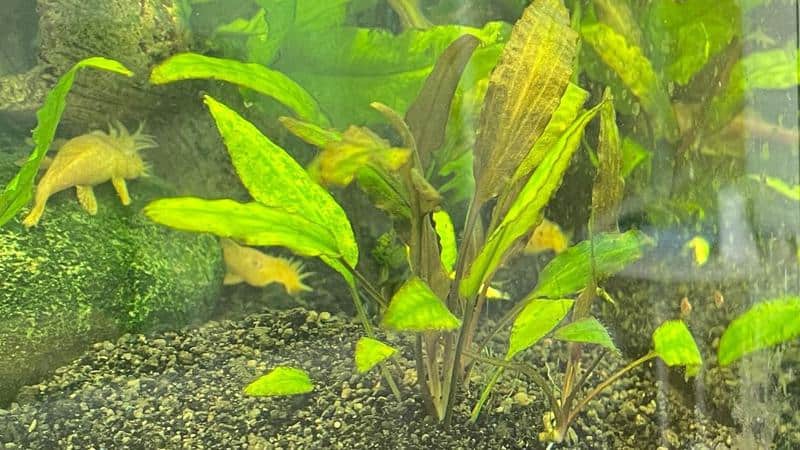
The cryptocoryne is a polymorphous species that can appear very different in growth form and physical appearance. It is a very durable plant capable of adapting to many substrates including sand.
Appearance
Though variable, cryptocoryne generally consists of green leaves with purple undersides and grows in the shape of a rosette.
The leaves specifically will change depending on the environment; for example, if it’s lighter, the leaves will darken and appear bushier, otherwise, they will appear longer and brighter under low light.
How to Grow
Cryptocoryne can handle a range of lighting conditions but will require enough nutrients such as root tabs or liquid fertilizer to stay healthy in the sand. Besides that, it doesn’t require CO2 and is rather slow growing.
It is essential that you keep optimal water conditions for this plant. And don’t worry if you see this plant shedding its leaves, it’s simply replacing them with new leaves more accustomed to the water environment.
| Maintenance | Low |
| Temperature | 75-82 F |
| pH | 6-7.5 |
| Size | 6” |
| Lighting | Low to Moderate |
| Fertilizer Type (if Required) | Root Tabs or Liquid Fertilizer |
11. Hornwort
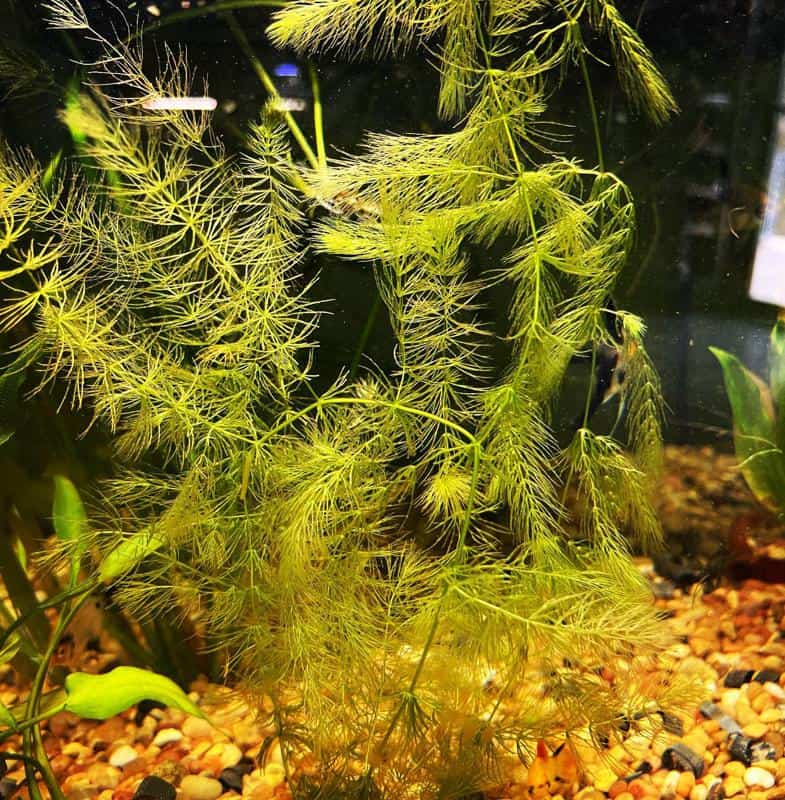
The hornwort is a very common plant found in the wild and is a commonly kept plant for beginners.
Appearance
Hornworts are typically found floating on the water surface, however, when planted in the substrate, they take the shape of a plump underwater bush with a plethora of branches and stems. Leaves are bright green, rigid, and thin.
How to Grow
Hornworts can handle a range of water conditions, including low to high light, however, it’s best if they have a constant dose of liquid fertilizer. It doesn’t require CO2, but having it will allow the plant to grow faster.
You may cut the stems if you feel they’ve grown too long, or replant those you’ve cut so that the plant may propagate.
| Maintenance | Low |
| Temperature | 50-85 F |
| pH | 6-7.5 |
| Size | 100” |
| Lighting | Low to High |
| Fertilizer Type (if Required) | Liquid Fertilizer |
12. Rotala Indica
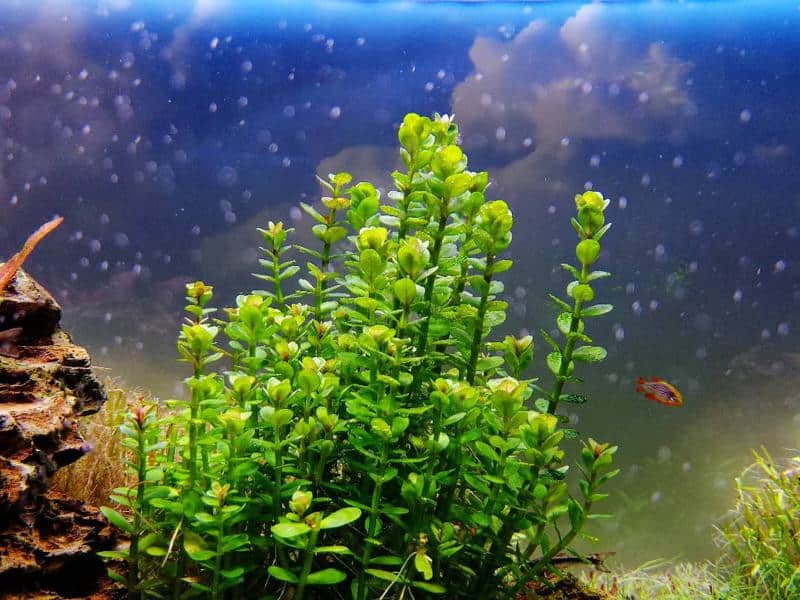
The Rotala Indica is an easy-to-grow plant that can be planted on sandy substrate. Though it’s a popular aquarium plant, it’s also known to be a weed in rice fields.
Appearance
This plant has standing stems that average about 4-8 inches tall, with thin, either round or oblong shapes that are roughly 1.5-2 cm long.
How to Grow
This plant is easy to maintain as it doesn’t require fertilization or CO2, as well as needing only moderate lighting conditions. However, if you add these things and apply high light, it can grow much faster and will oxygenate your water more efficiently.
This plant grows quickly, so be sure to trim it accordingly. Doing this will make the plant bushier.
| Maintenance | Medium |
| Temperature | 72-82 F |
| pH | 6.5-7.5 |
| Size | 14” |
| Lighting | Moderate to High |
| Fertilizer Type (if Required) | Root Tabs or Liquid Fertilizer optional |
13. Red Tiger Lotus
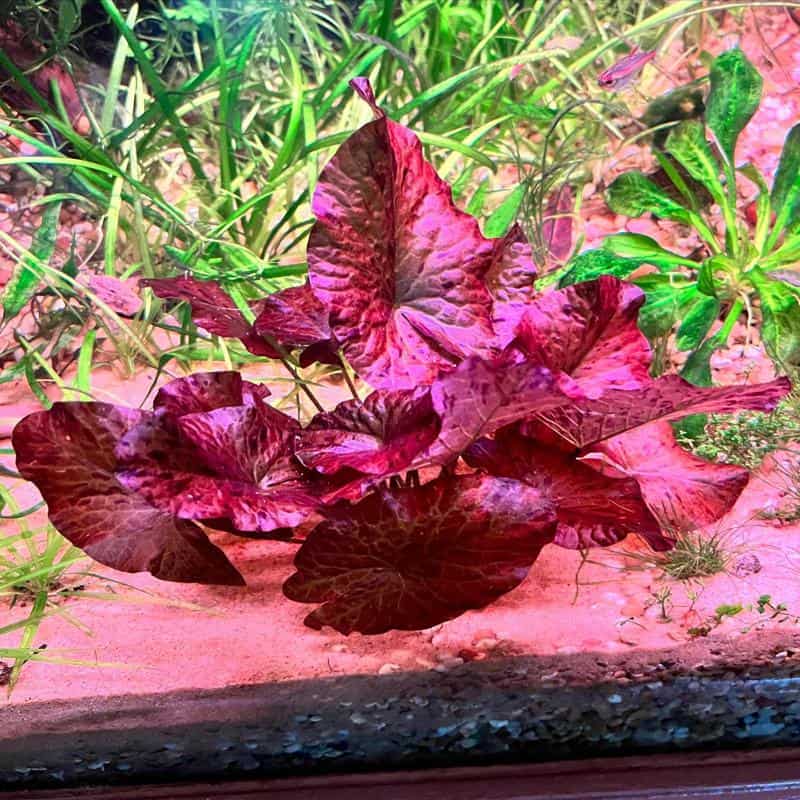
The Red Tiger Lotus is another easy-to-grow plant that is highly resistant to many water conditions. The Red Tiger Lotus, due to the shape of its leaves, is considered a lily pad.
Appearance
The Red Tiger Lotus is a freshwater plant that consists of arrow-shaped red leaves. Under strong lighting, its leaves can grow up to the surface of the water (in fact they can reach over a height of 30 inches and a width of 20 inches under optimal conditions).
How to Grow
This plant is available in bulbs with or without leaves, so all you’ll have to do is plant the bulbs about halfway into the substrate. Don’t bury it in entirely, otherwise, the bulb can start rotting.
Because this plant produces a large root system, it’s essential to contain the roots using a plastic container covered with a mesh fabric and filled with your sand substrate and root tab fertilizer. This will allow the plant to grow through the mesh while having its roots contained in the container.
It’s important to trim this plant regularly to prevent it from taking over your tank.
This plant can grow without CO2 and fertilizer, however, having both will allow it to grow much faster.
| Maintenance | Medium |
| Temperature | 72-82 F |
| pH | 6.0-8.0 |
| Size | Over 30” |
| Lighting | Moderate to High |
| Fertilizer Type (if Required) | Root Tabs optional |
Read More:
Conclusion
There are many types of plants that can live on a sandy substrate, some of which are very popular in aquariums around the world.
Follow the simple steps and keep the water consistent using this article, and you’ll have a beautifully made naturally appearing tank in no time.